If you are riding behind or in front of another rider, whether you know them or not, you can both help share the load, finds Stephen Huntley.
Understanding and using the skills of group riding will help you when you’re heading out and about with a buddy, riding with a number of friends, or even simply having a rider sit in behind you on your commute.
Hand signals
Try and get into the habit of regularly using hand signals. They will instill confidence in those riding with you, help them avoid potential hazards and give other road users a clear indication of what you’re about to do. If there are more than two of you, the signals should be repeated and passed down the line of riders.
Hand signals invariably mean taking one hand off the brake. The front brake, operated by your right hand, is the strongest and most efficient, but the rear brake brings you to a more gradual stop; choose whichever makes you feel the most in control. Sometimes, however, you will need both hands on your handlebars or brakes to maintain control of the bike, and timely signalling is not possible. If you don’t feel very stable or safe with one hand off the handlebars, or the bike seems to drift when you lift a hand, try to regularly get on a quiet trail and practise; it’s a skill you’ll quickly pick up.
As well as the signals shown here, you may come across others while out riding. Some bunch riders throw their right elbow outwards when they want you to pass and hold up their right hand when they are stopping due to a puncture. You might also see a rider wave their hand flat over the road; that normally indicates a hazard that is spread over the road, like broken glass or loose gravel.
Using a constant hand signal when in a roundabout is also a good idea. Try to continually point directly towards the exit you will be heading out on.
And finally, one of the most effective signals is a friendly wave to a motorist or rider who has shown courtesy.
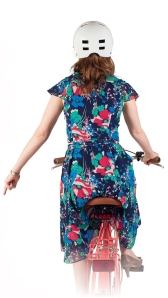 1. Debris/potholes
1. Debris/potholes
When a rider is sitting fairly close behind you in an attempt to reduce their wind resistance (drafting), they won’t have a very clear view of what’s happening up ahead, and they might not have time to see a hazard such as a pothole or a pile of broken glass. Give them as much advance warning as you can by pointing to the hazard as you approach it, and continue pointing as you go by it (but always keep your head up and your eyes on the road/trail ahead; don’t stare at the hazard).
 2. Turning
2. Turning
The only legally required hand signal for a bike rider is to indicate when they are turning or changing lanes to the right, but for the benefit of following riders and other road users, you should also indicate a left turn. Put your arm out in a straight line and point your hand towards the direction you are going. Be confident and unambiguous with the action and the signal. If you are moving right, do a very deliberate head check first, then signal. The head check and the arm movement combined are a clear indication to those behind, including drivers, that you are about to move right.
 3. Obstacle ahead
3. Obstacle ahead
If you’re approaching a parked car, or some other obstacle which you and the following riders will need to get round, swing your left hand behind the small of your back and point to the right. If you’re going to have to pull out to get around, have a look backwards over your right shoulder (a head check) to see if there’s anything coming up behind you before making the manoeuver.
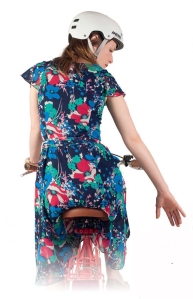 4. Slowing/stopping
4. Slowing/stopping
Riders may be following at a very close range, and bikes can pull up very quickly, so this is a signal you should use regularly as you slow down or prepare to stop. Throw your right arm back towards the following rider with your fingers spread and your open palm sweeping towards them. Make this signal very definite and pronounced, and hold your hand back for a few seconds to emphasise it even more.
5. Please overtake
There are times when you’ll want the following rider or riders to move ahead of you; maybe because you need to ride at a slower pace, or perhaps you are sick of being the one doing all the hard work into the wind. Use a pronounced sweeping motion with your right forearm and hand, palm facing forward, and repeat a couple of times. If it’s appropriate, move slightly to the left as you do this signal to make passing easier.
Calls
Verbal calls are another valuable tool to use when riding.
Call out “Passing” when overtaking a rider (always overtake on their right, and pass with consideration and care). If a car is coming up behind, call out “Car back.” Also call out “Door” in a very loud voice if one is about to open on you; it alerts following riders, and may freeze the car occupant into holding the door unopened.
You can also call out the name of any hazard as you’re approaching and pointing to it, and when signaling an obstacle ahead you can shout out the name of the obstacle; for example “Car up.” In a group of riders it can also help to call out “Stopping” or “Slowing” as well as doing the appropriate hand signal.
Drafting
A huge advantage of riding behind someone is that they take the force of the headwind, while you cruise along in their slipstream. You’ll only get the full benefit if you’re close enough; about 1-1.5m when you’re learning the skill, and as you get confident, about a bike wheel distant. Allow greater distances in poor conditions, and when going downhill.
You have to be constantly vigilant and alert when riding this close to someone. Don’t get caught staring down at their back wheel; keep your head up. There are three things you should be constantly scanning: the bum/middle-back of the rider ahead to judge how close they are; over their right shoulder to see what’s happening up the road; and through their front wheel so you’re seeing the condition of the road you’re about to ride over.
When drafting, don’t overlap any part of your front wheel with the back wheel of the rider ahead; always stay behind unless overtaking. You can line up directly behind the back wheel of the rider in front, but many riders like to line up very slightly to one side; this gives a clearer view ahead and a bit more room to manoeuver.
Be wary of sitting in too close behind someone seated and riding up a hill. If they get out of the saddle they may dramatically decelerate, or even pull the bike slightly backwards, and you’ll be on top of them before you know it.
Etiquette
- Try to ride predictably, with no sudden movements.
- If you have a mechanical fault, or any other reason to stop in
an odd place, pull over and get completely off the road/trail. - If you happen to come across a group of riders who clearly
know each other and are riding together, don’t automatically
assume you can join their group; be polite, and ask. - Try not to brake too hard, or too often. Look ahead and
anticipate, and if you need to slow down, try sitting up and
increasing your wind resistance; your drag can often achieve
the desired effect. - Don’t always be the draftee; if you’re able, take your turn
riding into the headwind. - You are legally allowed to ride two-abreast, as long as you’re
not more than 1.5m apart. But common sense should indicate
that sometimes it just isn’t appropriate. It might be unsafe
(for example, over the crest of a hill following a blind corner)
or you might be inconsiderately holding up traffic. Use your
judgement, and err on the side of caution and good manners. - And a final courtesy note; if you wear well-worn lycra knicks,
when you bend over on the saddle they can become very
taut and transparently thin – like sheer tights – and will give
those following a very clear, and perhaps unwelcome, view of
your rear end. If you’re not sure how threadbare your knicks
have become, get a (close) friend to check you out from
behind while riding.
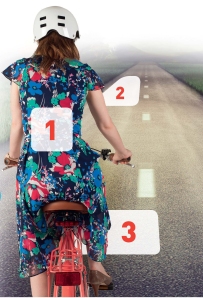 Where to look when following another rider
Where to look when following another rider
1. The lower back
Judge your following distance by looking at the lower back of the rider in front. Do not focus on the rider’s rear wheel.
2. Over the shoulder
Glance over the shoulder of the rider in front to see what is coming up ahead of you.
3. The front wheel
Glance down at the front wheel of the rider ahead to check on the state of the road you are about to ride over.
Ride On content is editorially independent, but is supported financially by members of Bicycle Network. If you enjoy our articles and want to support the future publication of high-quality content, please consider helping out by becoming a member.

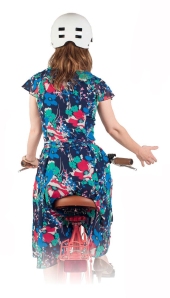
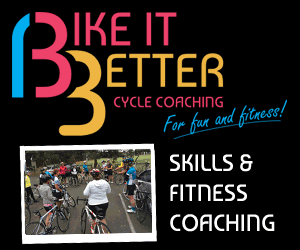
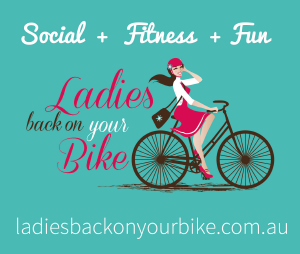
Great tips. Here in Brisbane Australia, we wave our hand behind our back rather than pointing for parked cars. Maybe we’re just not coordinated enough to point 😉 .
Great to have this type of education out there for all riders, not just racers.
The article does say you should wave your hand behind your back to pass a parked car:
“3. Obstacle ahead
If you’re approaching a parked car, or some other obstacle which you and the following riders will need to get round, swing your left hand behind the small of your back and point to the right. If you’re going to have to pull out to get around, have a look backwards over your right shoulder (a head check) to see if there’s anything coming up behind you before making the manoeuver.”
If you are in a group about to overtake other riders a quick look over the shoulder before passing other riders and a call of clear gives those in front the ok to overtake
How about “don’t draft total strangers”. Up with that is “don’t pass on the left”, and “don’t pass someone then immediately either slow down or turn left”. Also “might is not right” – bunch riders do not have automatic right of way over solo riders, nor is it ok for them to ride solo commuters into parked cars.
there’s nothing wrong with drafting stranges as long as you take your turn, I get drafted often and couldn’t care less and if I’m hurting I’ll happily draft for a bit to recover, we’re all out there together it doesn’t hurt to help each other…!
Totally agree with Sandocraft, I’m happy for anyone to draft of me. What is nice is a little call of thanks when they or I turn off. Really makes my day to have helped someone.
Drafting in the city? I hope this isn’t referring to the daily inner city Melbourne commuters.
If people are riding fast enough to break drag that is somewhat inconsiderate.
Justin, I think it was mainly referring to riding on bike paths or in bike lanes outside of the inner city.
However, I would think that drafting in the inner city is not a good idea for a different reason: the road situation changes too quickly. I am surprised by your comment about speed, because speed limit is 40 and you don’t complain about cars.
You are theoretically all correct however I suspect the first comment was more along the lines “don’t draft behind strangers until you are sure they are experienced and will participate in signalling etiquette”. I always watch from a safe distance first to see if they will signal. I also won’t join undisciplined packs where 2nd, 3rd and 4th row pairs are constantly turning heads to talk to the rider alongside instead of concentrating ahead.
Why “don’t draft total strangers”?
I don’t mind if someone rides behind me, even if there is no chance that one will go in front later. It is even better if that someone helps later. I am pissed off when someone sitting behind me for several kilometers sprints uphill to pass me, but that’s a different story.
I’m sorry, I don’t agree. I really really hate total strangers (or even those I see regularly on the ride) up my backside. I’m not there to ease their ride and don’t expect or want them to reciprocate. I generally pull over a bit, wave them thru, or if they are just not getting it, tell them to pass. You wouldn’t do it in a vehicle, so why on a bike? And you wouldn’t walk right up behind someone on the footpath either. Both dangerous and rude.
I agree with SC – I have had a strange male draft off me in the past and as a lone female commuter I found it extremely off-putting and creepy. It made me feel incredibly uncomfortable and unsafe. The points in this article about where to look when drafting just made me feel even more disgusted. I like my personal space at all times, including when riding! Please be considerate of other riders and the situation you may be putting them in, and definately ask their permission before riding closely – to me that is only a behaviour that should be carried out amongst riders who know each other.
Great info. I will have to practice taking one hand off the handle bars. Practice practice ………
I’m familiar with the wave/point behind to warn following cyclists of obstacles ahead, but often find myself torn by the need to also signal to the right to let passing vehicles know I’m moving further into the lane.
This sometimes confuses following riders but, as the fatal accident in Sydney over the weekend demonstrates, it is essential to give motor vehicles plenty of visual warning of your intentions as well as those behind.
Another pair of signals I use is for cars on windy roads, or where there are obstacles. If it’s not a good time to overtake (eg, I can see an oncoming car, or we’re about to pass a traffic island), I hold out my right hand in a “stay back” motion. Then, when it’s clear, I do a kind of circular “on you go” pattern with finger outstretched.
I think it’s good to communicate with cars, and to show that actually I do care about them being able to get where they’re going – if they’d just mind waiting a few seconds till it’s safe..
You can never signal too much! Was using hand signals and verbal calls whilst doing a slow tour of Buenos Aires recently. One of the group made a point of thanking me as it made her more confident (as someone who rarely rides) on the road.
+1 to the thank you wave to courteous drivers too, good way to promote the cause!
+2 to the thank you wave to courteous drivers. Spread the positive culture.
Love the thank you driver waves!
+4 for the thank you wave – to drivers AND also to pedestrians who kindly move over on shared paths when I warn them that I’m passing with my bell
When I was at school (many years ago), police would visit and explain the road rules applicable to cyclists. Hand signals for turning and stopping are an integral part and are to be used by law. Of course additional hand signals have evolved over the years, as discussed in the article.
The most difficult situations for cyclists is that most motorists do not know our rights – e.g. many are likely to take your right arm off rather than back off, when you indicate to turn right or wish to move to the centre of the road to negotiate a single lane round-a-bout. The other favourite manouvre by motorists is overtaking a cyclist just before turning left (either at an intersection or round-a-bout) then slowing right down and forcing us off the road or brake hard. Bottom line, we have to be extremely vigilant and assume all motorists are out to get us – defensive driving.
The more you act responsibly and confidently on the carriageway the more you are earning respect for all cyclists. We all have a responsibility to market the sport and hopefully, just hopefully, we may prevent a fellow cyclist from getting the abuse we may have deserved as a result of some inconsiderate or foolish act previously. United we stand!
I’ve never understood why some people object to being drafted by strangers. Ever since I read some research somewhere that when 2 cyclists ride in line it reduces the lead cyclist effort by 5%, I’m more than happy to have someone ride behind. Also it’s often the way cycling friendships start. Finally, although it is annoying when people overtake and then slow down, if they have been riding behind for a while maybe they didn’t realise just how much effort the draft was saving them. It takes time to learn whether you can sustain a higher, or even the same speed as the lead cyclist.
The objection to drafting is about safety. When I was new to road cycling, I was unaware of hand signals, I braked too hard too often and I didn’t look ahead far enough. You wouldn’t have wanted me following you, and you certainly wouldn’t have wanted to follow me.
If you’re following a stranger, be very careful… and choose your stranger carefully! 🙂
Why wouldn’t I want (old) you to follow me? It seems to me that none of the situations you described would affect the front rider.
Besides, when you was new to road cycling, have you been cycling fast enough to be followed? (Not saying you have not been, I am just curious what the chance is that someone inexperienced is a front cyclist)
As someone who has got into road cycling recently with pretty strong legs from other sports, I would consider myself to be one of those people – I ride fast enough that people sit on my back wheel but until reading this article I was unsure of the appropriate hand signals for many of the situations I encountered. The people who have chosen to follow me have found that out the hard way, with several near accidents…
Thankfully I now feel better prepared for my future rides, so thanks to the author and fellow commenters!
I have a question – is there any research relating to how much more effort the lead rider has to expend to ‘drag’ someone else? I see in one of the comments above someone reckons it makes the lead rider’s effort 5% LESS. I find that incredibly difficult to believe. I ride solo and I do not like riders tailgating me – I hate having someone so close behind me – I simply stop pedalling and let them move on. Similarily I don’t slipstream other riders either – its bad manners, but I’d be interested to know what effort it costs?
To be aerodynamic air must pass you smoothly both coming in AND leaving…otherwise you get a vacuum behind you that sucks you backwards.
This is why non-supersonic jets are bulbous at the front and slip off to a pointy bit at the back. Its also why boxy diesel trucks have filthy rear ends.
So in this case the person behind fills that vacuum and it moves behind them, so they do the work for that.
Without looking it up, the 5% I guess is based on high speed work on the track, so perhaps not relevant to lower speeds with crosswinds etc
Drafting a stranger , fine ! its a compliment ! means your riding fast, smooth and safe, they won’t stay behind you if your all over the place . Its over taking on the left up or down hills , I just dont get it, Unsafe !! Also what I don’t get is when sitting at lights by yourself at the front, when a group comes through only to push pass to be in front , then get upset because you join there group, as your going the same way !!!!
Anyway safe cycling means more cycling .